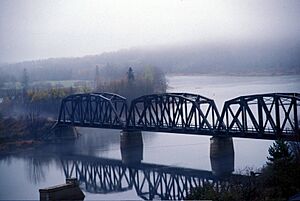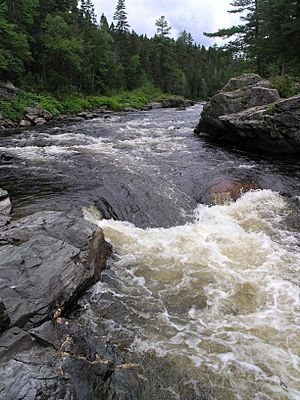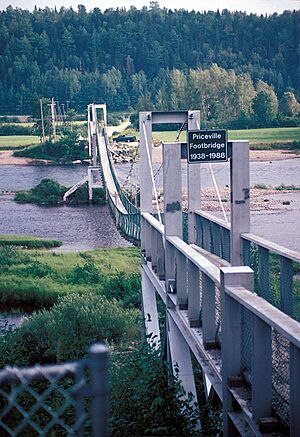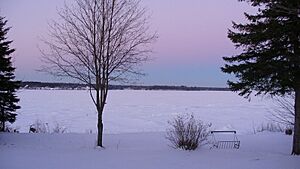Miramichi River facts for kids
The Miramichi River is a big river in the east-central part of New Brunswick, Canada. It flows into Miramichi Bay, which is part of the Gulf of Saint Lawrence. The name "Miramichi" might come from old Montagnais words meaning "Mi'kmaq Land." Today, the river is so important that it even has a special symbol, the Miramichi Herald, at the Canadian Heraldic Authority.


Contents
Geography
The Miramichi River system covers a huge area, about one-quarter of New Brunswick. This area, called a watershed, is about 13,000 square kilometers. A small part of this, about 300 square kilometers, is an estuary, which is where the river meets the sea.
The watershed mostly covers Northumberland County. It also includes parts of Victoria County, Carleton County, York County, Gloucester County, and Sunbury County.
River Branches
The Miramichi River itself is about 250 kilometers long. It has two main branches: the Southwest Miramichi River and the Northwest Miramichi River. Both of these branches have their own smaller rivers, called tributaries, that flow into them.
Many bends in the river have special names. This shows how important the river is to people who fish, canoe, or work with lumber. The ocean's Tides reach far up the river. They go about 70 kilometers inland, reaching Sunny Corner on the Northwest Miramichi and Renous-Quarryville on the Southwest Miramichi.
The two main branches join together at Newcastle. From this point, large ships can travel on the river.
The Estuary
The part of the Miramichi River that flows through the city of Miramichi is an estuary. This means it's a "drowned river valley." Over time, the sea level has risen, filling the river's mouth with saltwater.
The estuary is protected from big ocean storms by barrier islands. Even though it's not very big, this estuary is a very important ecosystem. It's where the fresh water from the Miramichi River mixes with saltwater from the Gulf of Saint Lawrence. This mix creates a rich environment for many plants and animals.
The estuary changes a lot throughout the year. In spring, there's a lot of fresh water from melting snow. In summer, the water gets saltier. In fall, ocean storms can change the shape of the barrier islands. In winter, the whole estuary freezes over with sea ice. The inner bay is only about 4 meters deep on average. This means the water gets quite warm in the summer.
Tributaries
Here are some of the important smaller rivers that flow into the Miramichi River:
- Bartibog River
- Napan River
- Bay du Vin River
- Black River
- Northwest Miramichi River
- Sevogle River
- Little Southwest Miramichi River
- North-Pole River
- Tomogonops River
- Portage River
- Little River
- Southwest Miramichi River
Geology
The Miramichi River starts in the Miramichi Highlands. These highlands are part of the Appalachian Mountains and are made of old rocks from the Silurian and Ordovician periods. The river's tributaries flow east into the New Brunswick Lowland, which covers much of the province.
Over a long time, the river has carved out the "Miramichi River valley." Both the Northwest and Southwest Miramichi rivers flow through this valley. Along their path to Newcastle, they are surrounded by low hills covered in thick forests. The highest points in the Miramichi River area, like Big Bald Mountain and the Christmas Mountains, reach about 750 meters above sea level.
The soil in the Miramichi River watershed is usually acidic and doesn't have much topsoil. This makes it hard to grow crops. Closer to the coast, the river banks show newer rocks from the Carboniferous period, hidden under sandy topsoil. You can also see Sandstone rocks along the river banks.
Fisheries
The Miramichi River and its smaller rivers used to have one of the biggest populations of Atlantic salmon in North America. Atlantic salmon are anadromous fish. This means they hatch and grow for a short time in fresh water. Then, they swim to the ocean to grow into adults. After they are grown, they return to the same fresh water to lay their eggs and complete their life cycle.
Today, the Miramichi River still has a healthy number of Atlantic salmon. It also has other fish that swim between fresh and salt water, like American Shad, smelt, herring, and sea-run brook trout. About half of all Atlantic salmon caught for sport in North America come from the Miramichi River and its tributaries.
Fishing Regulations
Fishing for Atlantic salmon is only allowed using fly fishing. Also, any large salmon caught must be released back into the river alive. This helps protect the fish that will lay eggs. Because fishing here is carefully controlled, all anglers (people who fish) should contact the New Brunswick Department of Natural Resources. They need to get the specific rules and permits before fishing. Special licenses and salmon "tags" are needed. Sometimes, parts of the river are closed to fishing to protect the salmon.
The salmon start swimming upriver in mid-June and continue until late October, when they begin to lay their eggs. It's believed that different groups of salmon, heading for different parts of the river, arrive at different times of the year.
Popular flies used for salmon fishing on the Miramichi River include the Black Bear series, Cosseboom series, Butterfly, Oriole, and the Blackville Special. Flies made from deer hair, like the "Buck Bug" or the "Green Machine," are also very successful. Many of the best salmon fishing spots on the Miramichi River are owned by private clubs. There are only a few "public water" areas where anyone can fish. Also, if you don't live in New Brunswick, you must hire a registered guide to fish for Atlantic salmon. You can find guides in the village of Doaktown or through the Department of Natural Resources offices.
Environmental History
The Miramichi River has an important environmental story that brought attention to New Brunswick. It was known as one of the best salmon rivers in North America, used for both fun and for people to catch food.
In the early 1950s, a problem started with spruce budworms, which were harming trees used by the local paper industry. To stop the budworms, a chemical called DDT was sprayed from planes over the Miramichi area. People thought DDT would only hurt the budworms. So, planes sprayed it over the whole region, including the rivers.
This chemical spraying badly affected the river and the living things in it, especially the wild salmon. Soon after the spraying, many dead salmon washed up on the riverbanks. Only about one-third of the baby salmon and one-sixth of the adult salmon survived. The spraying also hurt the salmon indirectly by killing the insects they ate.
Spraying DDT to fight the spruce budworm problem changed the entire ecosystem of the Miramichi River. This event was written about in a famous environmental book called Silent Spring by Rachel Carson in 1962. Silent Spring had a huge impact on the environmental movement in the 20th century. It showed problems in small areas like Miramichi, New Brunswick.
The environmental movement in New Brunswick grew, and many different groups got involved. Local news, scientists, outdoor lovers, and regular people all helped. Eventually, the government put limits on DDT spraying in the province. This series of events showed that industrial development can have negative effects on the environment.



